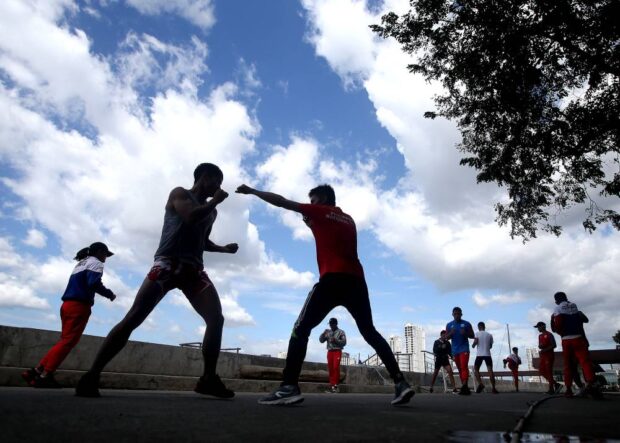
When I was diagnosed with Young Onset Parkinson’s Disease (YOPD), I learned that it’s a long-term degenerative disorder that affects movement and the nervous system. Symptoms include tremors, rigidity, slowness, and posture, balance, speech and writing challenges.
It has no cure, but I can slow its progression with intense exercise. Cycling is the activity with the most studies done; however, I do not enjoy it because it’s expensive and I don’t like working out with props. I prefer activities like yoga and martial arts for their honesty, accessibility and affordability. I also appreciate their meditative aspect, discipline and camaraderie.
Here are some martial arts that have been shown to ease PD symptoms:
Taekwondo
In his blog, university professor, musician and PD patient Nan Bahr shared a detailed account of the impact of his taekwondo training three to four times a week for about 10 hours.
Five years after diagnosis, general research literature indicates that Bahr should have been experiencing stage 3 PD symptoms: difficulty in dressing and eating, notable loss of balance, slower movements, cognitive impact and lots of falls.
Instead, he reported that his condition was almost the same though a resting tremor remained. Bahr’s medication did not vary over this period yet he didn’t see any cognitive decline, brain fog or difficulty understanding challenging problems. He noted that his musical skills, handwriting, speech, sleep patterns and metabolism stayed the same.
His training entailed stretching, intense form demonstrations that use the entire body (kicks, punches, blocks, balancing, sparring) and self-defense actions with fine motor (hand grabs) combined with gross motor control. Bahr observed that taekwondo requires general coordination, quick response and unhesitating fearlessness in committing to demanding, complicated sequences (like spinning and jumping kicks).
He noted that PD sufferers tend to be reluctant in their movements, especially with balance. “Martial arts requires practitioners to act instinctively and anticipate their responses to potential attack scenarios, which places a level of cognition unmatched by a program for regular walking,” said Bahr.
Kicking, especially spinning ones, demands consistent focus on balance. Taekwondo kicks depend on coiling the body up and quickly unraveling the hips so that the kick connects with the force and core strength. Also unique to taekwondo is how your joints fold so the strike is let go like a spring.
Martial arts movements are deliberate, intricate, synergistic and health-promoting. You have to prepare for an opponent’s strike and escape fast while strategizing for a counter-response, with no time to think.
“I recommend taekwondo for people with Parkinson’s and perhaps for other neurologically based mobility and balance disorders,” said Bahr.
I returned to taekwondo training after 20 years and recently earned my brown belt. It was fulfilling for me as I never thought I’d get to go back after such a long hiatus with a discouraging prognosis. The confidence I gain from training boosts my spirits and gives me hope. The yelling helps strengthen my vocal cords so I won’t lose my voice.
Boxing
Rock Steady Boxing is a nonprofit organization that offers a noncontact boxing-based curriculum for people of all fitness levels and stages of PD worldwide. It’s unavailable in the Philippines, but many boxing gyms and home-service trainers can tailor-fit a program.
Dr. Stephanie Combs-Miller, director of research for the Krannert School of Physical Therapy, told CBS News that PD patients who boxed over two years didn’t see any disease progression. “In some cases, they were better … it enhances dopamine uptake in the brain and can improve the growth of neurons.”
She also observed that participants retained a higher walking speed, better endurance and balance. “The most surprising thing was, they perceived a higher quality of life over those two years than people that engaged in other kinds of exercise,” said Combs-Miller.
I boxed for several years over a decade ago but when I took it up again before diagnosis, my tremors intensified. When I trained again under medication, the tremors didn’t reoccur and the release from hitting was incredibly cathartic.
Karate
Family physician Steven Eisenstein teaches karate in his spare time to negate the neurologic progression in people with PD.
“Karate … seemed to be the polar opposite of Parkinsonism; karate is dynamic, smooth, loud and balanced, whereas Parkinson’s makes a person shaky, slow, quiet and unsteady,” he said.
In Chicago, researchers from Rush University and sensei John Fonseca collaborated to create Kick Out PD, a karate program for people with PD. In a 10-week trial, those with mild and moderate PD experienced fewer falls.
At a neurologylive.com podcast, Dr. Heidi Moawad and Dr. Jori E. Fleisher shared the benefits of karate for movement disorders. As the karate instructors knew that some participants may have impaired balance, they kept a small teacher-to-student ratio and addressed participants’ fear of falling by teaching them how to fall safely and get up.
Martial arts help balance and core strength. Movement patterns on one side of the body are executed on the other, which is crucial for PD sufferers who usually have a “worse” side they favor. This attention to symmetry compels them to use that side once more. The mindfulness, sense of camaraderie and achievement integral to a practice can address nonmotor symptoms like anxiety and depression.
“Rather than sitting in a support group, participants felt they could shed their PD stigma at the door, that they were in a safe space and shared their pride in watching their classmates improve. It was a big motivator for those who stuck with it during our six-month follow-up, and continue to do so today,” said Fleisher. —CONTRIBUTED